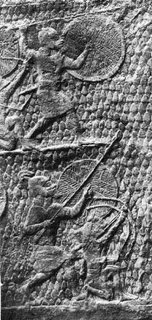For a while now I've been meaning to write about the infernal bureaucratic road one has to follow when building a new house in Israel. But every time I started writing I found myself wondering where to begin, how to convey the horror of it all in one post - thoughts which quickly led to despair and abandonment of the effort. The labyrinthian nature of this kafkaesque experience requires writing skill that are beyond my capabilities.
So instead of a comprehensive post I will tell of one small incident.
Our house is a semi-detached one, built behind a 5-storey building. The entrance to our house (and the other three adjacent to ours) is from the parking lot of the building, so one has to walk through the car entrance to the rear of the building before reaching the house. To the left of our house (and the building) is a public path that is about a metre below the level of the parking lot. Today, there is a fence between the parking lot and this public path.
A while ago, the four families living in the houses requested the local authorities to open a small opening in the fence and build a few stairs leading down to the public path. This way, people could enter our houses by walking down the public path and up the stairs, instead of walking all the way around the building and through the car entrance. Not to mention the safety issues of walking through the same road as the cars. Our request was backed with photographs and a draft engineering plan. After a short meeting at the city hall, the appropriate bureaucrat approved the concept "in principle" and everyone was happy.
A couple of months ago we received a letter saying that upon re-consideration the request was denied. No explanations given. We wrote a letter back requesting another meeting to understand this reversal of decision. After a few weeks of silence, and several phone calls, another bureaucrat agreed to see us. In the meeting, she produced a letter (supposedly sent to us but which we never received) saying that the decision was reversed because after a "visit by professionals" to the area they realized the height difference between the public path and the parking lot is "more than 2.5 metres" and thus requires a "significant" flight of stairs, which is unacceptable.
Sounds fair enough, right? After all, why construce a massive of more than 10 stairs on a public path just to satisfy four families? Well, not so easy. This morning I took a measuring tape and checked the height difference. Turns out it is less than a metre... All it takes is 3-4 stairs.
So what are the possibilities? Perhaps nobody ever came on-site and the city hall just thought they could brush us off with a letter? Or perhaps the measuring tape of the "professionals" they sent was a biblical one and they measured amot instead of metres? Or perhaps this is just standard procedure and we need to go through the "proper" number of meetings, phone calls, letters and voice-raising scenarios before getting to a positive resolution of the matter.
And this is just a drop in the ocean. Oh, if I were to start writing about the other hundreds (yes, hundreds) of problems one has to solve in order to find peace and tranquility under a new roof. A heartfelt recommendation to anyone considering building a new house in Israel: DON'T. Buy an existing one instead and spend your time and energy in renovating it.



